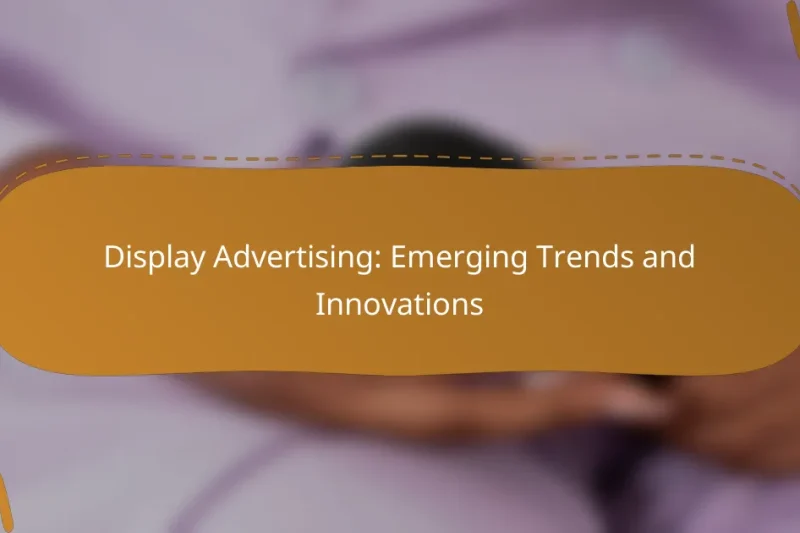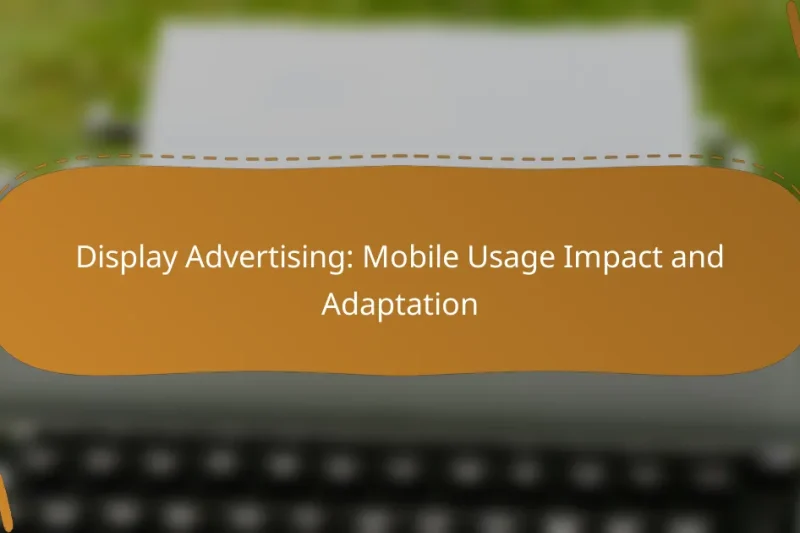As sustainability becomes a central focus in display advertising, brands in the UK are increasingly adopting … Display Advertising: Sustainability Trends and Creative ImpactRead more
Current Trends in Display Advertising
Current trends in display advertising are centered around the integration of advanced technology and innovative formats to improve targeting and user engagement. With the rise of AI and programmatic advertising, advertisers can automate processes and optimize campaigns in real-time, leading to enhanced performance and a better return on investment.
Display Advertising: Emerging Trends and Innovations
Display advertising is rapidly evolving, driven by advancements in technology and data utilization. Emerging trends such … Display Advertising: Emerging Trends and InnovationsRead more
Display Advertising: Future of Interactive Ads and Engagement
As display advertising evolves, interactive ads are poised to transform user engagement by offering personalized and … Display Advertising: Future of Interactive Ads and EngagementRead more
Display Advertising: Mobile Usage Impact and Adaptation
Mobile usage has transformed display advertising by changing how users engage with content and interact with … Display Advertising: Mobile Usage Impact and AdaptationRead more
Display Advertising: Privacy Regulations and Compliance Strategies
In the evolving landscape of display advertising, understanding and adhering to privacy regulations such as GDPR … Display Advertising: Privacy Regulations and Compliance StrategiesRead more
Display Advertising: AI Targeting Techniques and Benefits
AI is revolutionizing display advertising by employing sophisticated algorithms to analyze extensive data, allowing advertisers to … Display Advertising: AI Targeting Techniques and BenefitsRead more
What are the current trends in display advertising?
Current trends in display advertising focus on leveraging technology and innovative formats to enhance targeting, engagement, and user experience. Advertisers are increasingly adopting advanced tools and strategies to optimize their campaigns and reach their audiences more effectively.
Increased use of AI for targeting
The use of artificial intelligence (AI) in display advertising is transforming how advertisers target their audiences. AI algorithms analyze vast amounts of data to identify patterns and predict user behavior, allowing for more precise targeting.
Advertisers can utilize AI to create personalized ad experiences based on user preferences and past interactions. This approach can significantly improve engagement rates and conversion outcomes, making campaigns more effective.
Growth of programmatic advertising
Programmatic advertising is rapidly growing, automating the buying and selling of ad space in real-time. This method allows advertisers to reach specific audiences at scale while optimizing their budgets through data-driven decisions.
With programmatic advertising, marketers can bid for ad placements based on user demographics, interests, and behaviors. This efficiency not only saves time but also enhances the effectiveness of ad spend, often resulting in better ROI.
Emphasis on video content
Video content is becoming increasingly important in display advertising, as it captures attention more effectively than static images. Advertisers are integrating video ads into their campaigns to enhance storytelling and engagement.
Short video formats, such as those used in social media platforms, are particularly popular due to their ability to convey messages quickly. Brands should consider incorporating video ads to improve user interaction and retention.
Focus on mobile optimization
With the rise of mobile device usage, optimizing display ads for mobile platforms is crucial. Advertisers must ensure that their ads are visually appealing and functional on smaller screens to capture the attention of mobile users.
Responsive design and fast loading times are essential for mobile ads. Brands should test their ads on various devices to ensure a seamless experience, as poor mobile performance can lead to high bounce rates and lost opportunities.
Integration of augmented reality
Augmented reality (AR) is emerging as a powerful tool in display advertising, allowing brands to create immersive experiences that engage users in unique ways. AR can enhance product visualization and interaction, making ads more memorable.
For example, furniture retailers can use AR to let customers visualize how a piece of furniture would look in their home. This level of interactivity can significantly boost user engagement and drive conversions.
How is AI transforming display advertising?
AI is revolutionizing display advertising by automating processes and enhancing targeting capabilities. It enables advertisers to analyze vast amounts of data quickly, leading to more effective ad placements and improved return on investment.
Enhanced audience segmentation
AI allows for more precise audience segmentation by analyzing user behavior, preferences, and demographics. This technology can identify patterns that traditional methods might miss, enabling advertisers to create highly targeted campaigns that resonate with specific groups.
For instance, AI can segment audiences based on real-time data, such as recent online activity or engagement levels, allowing for dynamic adjustments to advertising strategies. Advertisers can use this information to tailor messages and offers, increasing the likelihood of conversion.
Real-time bidding optimization
AI significantly improves real-time bidding (RTB) by analyzing multiple variables to determine the optimal bid for ad placements. This technology assesses factors like user engagement, time of day, and competitive bids to make informed decisions within milliseconds.
By leveraging machine learning algorithms, advertisers can optimize their bids to maximize visibility while minimizing costs. For example, AI can adjust bids based on predicted performance, ensuring that budgets are allocated efficiently across various platforms.
What are the benefits of programmatic advertising?
Programmatic advertising offers automated ad buying, allowing for more efficient and targeted campaigns. This approach leverages technology to optimize ad placements in real-time, resulting in better performance and cost-effectiveness.
Improved efficiency in ad buying
Programmatic advertising streamlines the ad buying process by automating transactions between advertisers and publishers. This reduces the time spent on negotiations and manual placements, allowing marketers to focus on strategy and creative development.
By utilizing algorithms, programmatic platforms can quickly analyze vast amounts of data to determine the best ad placements. This efficiency can lead to lower costs and faster campaign launches, often within hours rather than days.
Access to vast data insights
One of the key advantages of programmatic advertising is access to extensive data insights. Advertisers can gather information on audience behavior, preferences, and demographics, enabling more precise targeting.
With real-time analytics, marketers can adjust their campaigns based on performance metrics, optimizing for better results. This data-driven approach allows for continuous improvement and more effective ad spend, ensuring that budgets are allocated to high-performing ads.
How important is mobile optimization in display advertising?
Mobile optimization is crucial in display advertising as a significant portion of web traffic now comes from mobile devices. Ensuring that ads are tailored for mobile viewing can enhance user experience and improve overall campaign effectiveness.
Higher engagement rates
Mobile-optimized display ads tend to achieve higher engagement rates compared to non-optimized versions. This is largely due to the improved user experience, which includes faster loading times and better visibility on smaller screens. Engaging visuals and concise messaging can capture attention more effectively on mobile devices.
Consider using interactive elements, such as swipeable carousels or videos, which can further boost engagement. Testing different formats can help identify what resonates best with your target audience.
Increased conversion potential
When display ads are optimized for mobile, they can significantly increase conversion potential. Users are more likely to complete desired actions, such as making a purchase or signing up for a newsletter, when the process is seamless on their devices. A well-designed mobile experience can reduce friction and encourage quick decision-making.
To maximize conversions, ensure that landing pages are also mobile-friendly and load quickly. Implementing clear calls to action and minimizing the number of steps to complete a transaction can lead to higher conversion rates. Regularly analyzing performance metrics will help refine your approach and improve results over time.
What role does video content play in display advertising?
Video content is a crucial element in display advertising, significantly enhancing engagement and effectiveness. By incorporating dynamic visuals and audio, video ads capture attention more effectively than static images, leading to higher interaction rates.
Higher viewer retention
Video content tends to retain viewer attention longer than traditional display ads. Studies show that users are more likely to watch a video ad to completion, especially if it is engaging and relevant. This increased retention can lead to better brand recall and a higher likelihood of conversion.
To maximize viewer retention, consider keeping videos concise, ideally under 30 seconds, and ensure that the most critical information is presented within the first few seconds. Using captivating thumbnails and compelling hooks can also enhance initial engagement.
Enhanced storytelling capabilities
Video allows brands to tell their stories in a more immersive and relatable way. Through visuals, sound, and narrative, advertisers can evoke emotions and create a deeper connection with their audience. This storytelling aspect can differentiate a brand in a crowded market.
When crafting video ads, focus on a clear narrative arc that aligns with your brand message. Incorporate elements like customer testimonials or behind-the-scenes footage to humanize your brand and foster authenticity. Aim for a balance between entertainment and information to keep viewers engaged while conveying your message effectively.
What are the emerging technologies in display advertising?
Emerging technologies in display advertising include augmented reality and interactive ad formats, which enhance user engagement and provide immersive experiences. These innovations leverage advanced digital tools to create more dynamic and personalized advertising strategies.
Augmented reality experiences
Augmented reality (AR) experiences in display advertising allow users to interact with digital content overlaid on the real world. For instance, a furniture retailer might enable customers to visualize how a sofa would look in their living room through their smartphone camera. This technology not only boosts engagement but also helps in decision-making, potentially increasing conversion rates.
When implementing AR, brands should ensure the experience is seamless and user-friendly. Poorly designed AR can frustrate users and lead to negative perceptions of the brand. Testing the AR experience across various devices is crucial to ensure compatibility and effectiveness.
Interactive ad formats
Interactive ad formats encourage user participation, making ads more engaging and memorable. Examples include quizzes, polls, and games that invite users to interact rather than passively view content. These formats can significantly increase click-through rates and dwell time, as users are more likely to engage with content that requires their input.
To maximize the effectiveness of interactive ads, brands should focus on clear calls to action and ensure the interaction aligns with the overall campaign goals. Additionally, monitoring user engagement metrics can provide insights into what types of interactions resonate best with the target audience, allowing for continuous optimization of ad strategies.





